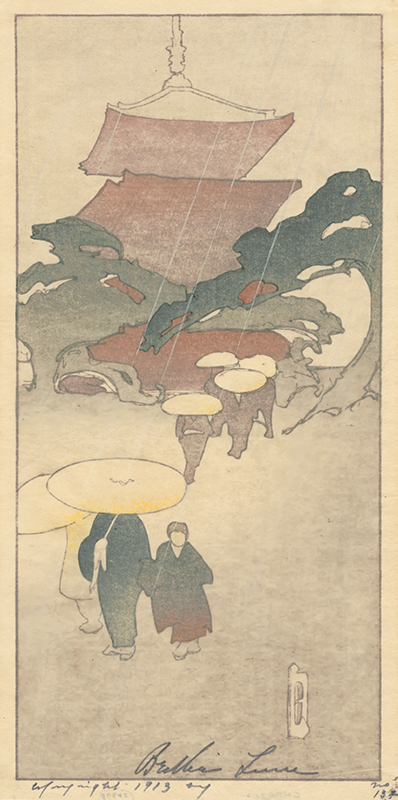
19th, 20th & 21st Century Fine Prints
707-546-7352 · fax 707-546-7924 · web: www.annexgalleries.com · email: artannex@aol.com
Temple in Rain - a.k.a. Pagoda in Rain; Temple in Mist; Mist and Rain by Bertha Lum

Temple in Rain - a.k.a. Pagoda in Rain; Temple in Mist; Mist and Rain
Bertha Lum
Temple in Rain - a.k.a. Pagoda in Rain; Temple in Mist; Mist and Rain
Bertha Lum
1869 - 1954 (biography)Two discrepancies of note: the Gravalos/Pulin catalogue raisonne dates "Temple in Rain" as 1916; this impression is dated 1913. Inconclusive dates are not unusual for Lum or for many printmakers of the time. G/P states that the edition for this image is not stated but is "around 89," and this impression has been annotated "No. 132" - which could be an edition number, an impression number, or something else entirely.
Lum wrote on the refined simplicity of the imagery found in Japanese color woodcuts on page 14 in her book Gangplanks to the East:
"There is a strange quality in the air here, even on a clear day. The sun shines, yet there is a mist which hangs low across the water and, whereas in other countries details are sharply defined as far as one can see, here everything is a series of silhouettes, the landscape carrying out the Buddhist belief in in the ghostliness of all existence and substance, the teaching that life is only a shadow play. The beauty of Japanese prints startled the world by the elimination of detail and their ability to reproduce a landscape in flat surfaces, gaining rather than losing effectiveness, and although they were unsurpassed painters it was the landscape, as much as the artists, that produced such an effect. Everything seen at a comparatively short distance appears flat, while beyond, the hills lie one against another, darkest at the top with their bases growing lighter, until they are lost in mist.


